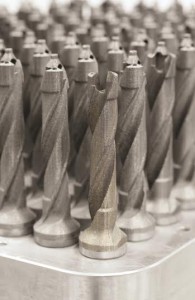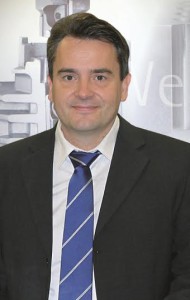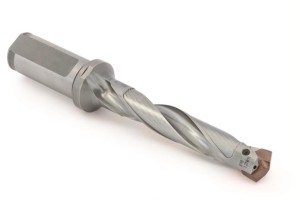 Mapal relies on additive tool solutions with LaserCUSING systems by Concept Laser.
Mapal relies on additive tool solutions with LaserCUSING systems by Concept Laser.
High performance, long service lives and rapid tool changes are the central requirements for modern tool concepts. The QTD insert drill excels with good chip deformation and reliable chip removal thanks to its geometry. The insert is held in a stable prism connection. These precision features make high cutting specifications and drill quality possible. Mapal offers four types of the inserts for steel, stainless steel, cast iron and aluminum.
The new Mapal QTD insert drill is certain to impress users. The drills have a lot to offer in detail. Additive manufacturing from metal powder using laser melting systems by Concept Laser makes entirely new design approaches possible. The QTD insert drill was previously available in diameters of 13 mm and greater. One reason for this is the coolant supply in the tool body. The smaller the tool body, the greater the adverse effect the standard central coolant supply on the tool’s performance. Central coolant supply weakens the core of the drill and makes it unstable. In addition to this, the cooling channels must be ever smaller. That reduces the flow of coolant to the insert. The new steel tool body design with spiral cooling channels is not usually used for small diameters. The new design now allows even solid drills to be produced in the 8 to 12 mm diameter range.
The new QTD-series insert drill are manufactured using additive laser melting. These are hybrid manufactured parts: the tool shank is machined conventionally and the drill is laser melted with additive methods. This approach makes the manufacturing process significantly more economical. 
Dr. Dirk Sellmer: “Hybrid strategies are the ideal method of choice: Simple component parts are machined and more complex areas are then built up additively.” Unmanned manufacturing and a reduction of tooling-up times and reworking in the digital laser melting approach are other aspects which improve the economy. However, the greatest advantage of transitioning from a conventional manufacturing strategy to additive manufacturing was that it facilitated an entirely new geometry, increasing the performance of the tools. Dr. Dirk Sellmer: “The additively manufactured insert drill has a cooling concept with spiral ducts, which improves the cooling performance. Compared with the previous central coolant supply with y diversion, a spiral coolant routing increases the coolant flow by 100%.” It also increases the core stability with coolant ducts which run parallel to the flute. The cooling is also improved by the new coolant duct profiles which deviate from the usual circular form with a slightly triangular shape. That optimizes the geometrical moment of inertia and the flow rate. Tests found that choosing a cross section of this type increases the flow quantity by 30%. Coolant profiles like this cannot be produced conventionally. The coolant flows at a pressure of 1.6 to 3 bar. 
Overall, the new cooling concept means that better cooled drills are available for longer drilling tasks. It also allows to expand the range with smaller drill diameters. Stainless steel 1.2709 is used. According to Dr. Sellmer, the powder requirement is calculated from the effective construction weights plus 10%, and the scrap material is easy to recycle. Internal tension in parts is critical for rotating tool solutions by Mapal. Tension must be removed from conventionally manufactured parts after machining due to the immense forces to which they are subjected. That is not the case for LaserCUSING. The constantly changing exposure locations in the geometry mean that the tension is removed from the part internally during the build process.
Two Concept Laser M1 cusing systems with a central material supply container are used. The systems, from the medium performance range, have a build envelope of 250 x 250 x 250 mm. The QTD insert drills are created as 10×10 or 11×11 unit solution in this build envelope. 100 to 121 drills are produced in one set-up. The build rates of the 400 W lasers are between 6 and 18 cm³/h. In order to avoid contamination, the M1 cusing operates under a nitrogen protection gas atmosphere as usual. During processing, the laser heats the powder material to 60-70°C for fusing. The thermal expansion in the build process has to be taken into consideration in the design. However, after initial successes with series products, the demand for internal capacities is also growing, even though clever organization results in production availability of 24 hours, seven days a week with unmanned production. According to Dr. Dirk Sellmer, options include using multiple lasers in a system and/or a general expansion of capacity. In 2014, Dr. Kress, owner of Mapal, mentioned a need for at least 5 systems in the medium term.


